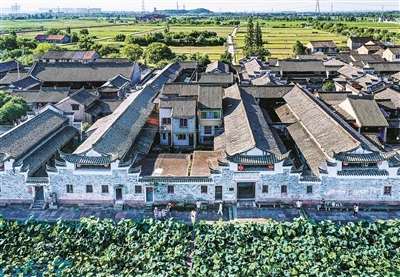
At 10:00 am on June 23, Ningbo's first rural coffee pop-up shop, Hetang Coffee(荷塘咖啡), opened in the Zoumatang Village(走马塘村)in Jiangshan Town, Yinzhou District.

There is a large lotus pond in front of the door of the coffee shop. With the arrival of midsummer, the lotus flowers in Zoumatang have begun to bloom, attracting many citizens to appreciate it.

If you go to a coffee shop, you can meet two young baristas, both of whom were born in 1999: one surnamed He, a native of Jiangshan, and the other surnamed Hu, a Yunnan native who has lived in Ningbo for many years.

"Last year, when two young members of the team came to Zoumatang for the first time, they fell in love with it and wanted to open a coffee shop here. As a team, we support them to have this coffee shop." Wu Dongri, partner of the Lotus Pond Coffee Project, told reporters that Zoumatang has a very deep history and culture. While opening this coffee shop, he also hopes to dig deeper into the local culture.

"There are many old grandmothers here who usually sell lotus root Jelly (木莲冻)in the village. We use these jelly to make special coffee in our drinks, hoping to encourage the villagers in the village to start businesses together,” said Wu Dongri.
This coffee shop is only open to the public during the lotus blossom period, that is, 118 days in the year, from 10 am to 7 pm every day. Come and enjoy the flowers and drink coffee.
Editor's Pick
The thousand-year-old ancient village of Zoumatang is located in Jiangshan Town, Yinzhou District. It is considered "one of the oldest settlements in Ningbo, where many great scholars were born, surrounded by majestic rivers and hills, and embraced by fertile lands and rivers".
In the village, there are many ancient buildings from the Ming and Qing Dynasties (14^th to early 20^th century). The villagers are simple and honest folk. Throughout the dynasties, 76 scholars from Zoumatang received the Jinshi degree, the highest and final degree in the imperial examination in Imperial China, earning the village the name "home of China's Jinshi ".

Historical records show the village was built in 988 AD during the Duangong Period of the Northern Song Dynasty, when a family surnamed Chen moved to the area from Changzhou, Jiangsu Province. Eight Ming Dynasty buildings and many Qing Dynasty buildings are still standing. There are also three buildings from the early 20^th century, bearing typical signs of Western architectural influence.
What makes Zoumatang Village even more impressive is its stone art, the best of which being the homes' stone lattice windows. Stone lattice windows are rare in China. The stone lattice windows of Zoumatang are not only exquisitely carved, but also rich in symbolism.
In an old residence near the village's North River, one window's stone latticework form the Chinese characters第一(di yi, "number one"), meant to inspire younger generations to seize the first place; another window's lattice form the characters乾坤(qian kun, "heaven and earth"), serving as a reminder for younger generations to always keep the world in mind and serve the country.


